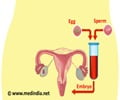Researchers have successfully transformed human embryonic stem cells into germ cells in a breakthrough discovery.
Researchers have successfully transformed human embryonic stem cells into germ cells in a breakthrough discovery. Germ cells are the embryonic cells that ultimately give rise to sperm and eggs.
The breakthrough will allow researchers to observe human germ cells-previously inaccessible-in laboratory dishes."This achievement opens a new window into what was only recently a hidden stage of human development. Laboratory observation of human germ cells has the potential to yield important clues to the origins of unexplained infertility and to the genesis of many birth defects and chromosomal disorders," Nature quoted Dr. Susan B. Shurin, acting director of the Eunice Kennedy Shriver National Institute of Child Health and Human Development (NICHD), as saying.
Dr. Reijo Pera, the study's senior author, explained that the ability to observe germ cells in laboratory cultures opens up several promising new avenues of research.
Although infertility is apparent only after sexual maturity, many forms of unexplained infertility are thought to have their origins in errors that occur in the cells of the early embryo, she said.
The research also advances the prospect of creating synthetic sperm and eggs in the laboratory to allow men and women who make none to have their own genetic children.
This, however, remains at least five years away, and would have to clear significant ethical and safety hurdles. The use of artificial gametes in reproduction was banned in Britain last year. Another potential benefit could be insights into spontaneous genetic mutations that cause disease and disability.
The researchers began with human embryonic stem cells, to which they added a gene that makes a protein which flashes green when a gene found only in germ cells is turned on.
After the embryonic stem cells grew and changed for two weeks, the researchers isolated the cells that flashed green.
The researchers next conducted a variety of tests to confirm that the green fluorescing cells behaved like germ cells.
Once convinced that their cells were in fact germ cells, the researchers turned on and off several candidate genes to see if those genes played a role in the development of stem cells into immature germ cells.
And they found that one candidate gene, called DAZL, was necessary to transform embryonic stem cells into germ cells.
The results of the study were published online in Nature.
Source-ANI
RAS











